2021 Toyota RAV4 Hybrid vs. 2021 Honda CR-V Hybrid: Compare Hybrid Crossover SUVs
Pickups aside, the Toyota RAV4 and Honda CR-V are the two top-selling vehicles in the U.S. And they’re both offered in high-mpg hybrid versions.
The CR-V and RAV4 flaunt the compact-crossover goodness—laid out in cargo-friendly layouts, easy seating heights, and all-wheel drive—that’s pulled Americans away from mid-size sedans. They also both offer mileage near or at 40 mpg, and they drive better and are more refined than their gas-only counterparts.
For those reasons and more, our crew of editors unanimously prefers the hybrids versus the non-hybrid versions. But which of these hybrids do we recommend over the other?

2021 Honda CR-V (CR-V Hybrid)
In styling, the RAV4 Hybrid definitely makes more overtures to SUV design, even if it isn’t ready to go do any boulder-crawling. Its 2019 redesign brought a more upright, chiseled look on the outside, along with chunkier controls inside that brought to mind the tough 4Runner. Launched for 2020, the CR-V Hybrid has a look that’s more restrained inside and out; it’s rakish and aerodynamic on the outside, but it doesn’t masquerade as anything it isn’t.
Nearly every automaker does hybrid systems differently, and these two are no exception. Under the hood of the Toyota RAV4 Hybrid you’ll find a version of the planetary torque-split system that replaces a conventional transmission and is an evolution of what Toyota has used in the Prius and other hybrid models for decades. There’s a 2.5-liter inline-4 plus a total of three motors. One of the two motors packaged in front helps provide propulsion, while the RAV4 Hybrid also has a third motor in back that propels the rear wheels and provides all-wheel drive—making 219 horsepower altogether. In the CR-V, a 2.0-liter inline-4 is used most often as a generator for the battery pack, while one of its two motors is primarily what powers the wheels, with a driveshaft to the rear wheels offering all-wheel drive—and making a net 212 hp.
In many types of driving, the CR-V feels perkier and has better drivability, mainly because the delivery of the electric motor makes it so responsive and consistent. Neither of these models are primed for performance driving, but they offer a reasonably comfortable ride and handling that’s a great compromise for most kinds of family use.
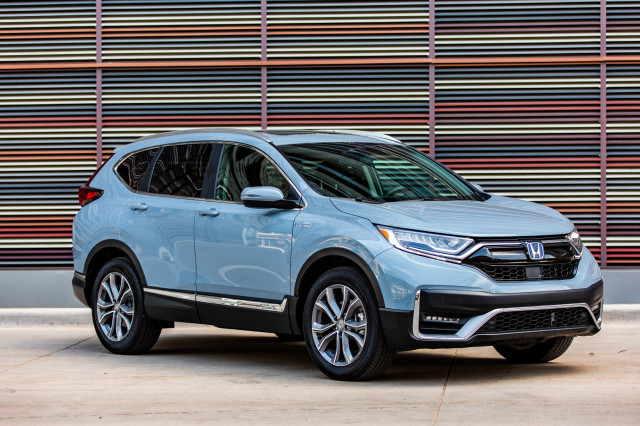
2020 Honda CR-V Hybrid
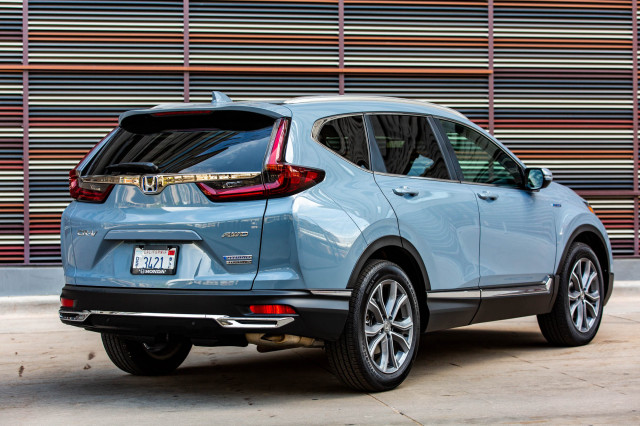
2020 Honda CR-V Hybrid
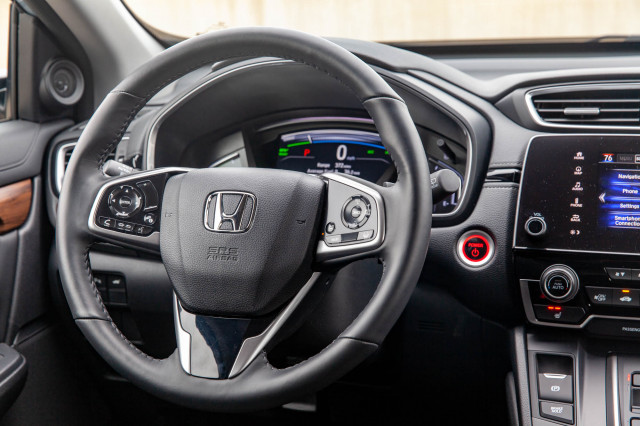
2020 Honda CR-V Hybrid
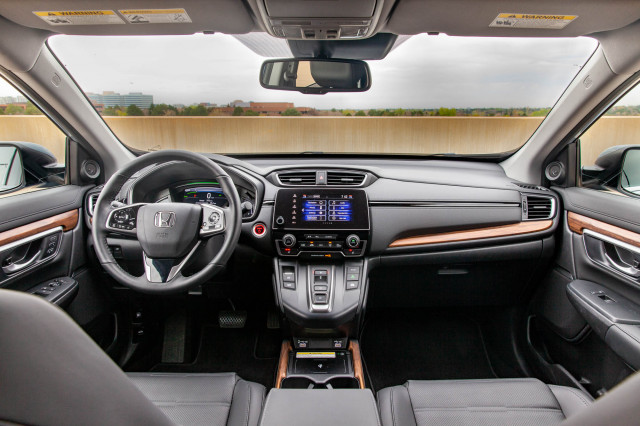
2020 Honda CR-V Hybrid
The CR-V hybrid has a clear advantage in passenger space, and while the RAV4 Hybrid loses points for its passenger comfort—mind the thin seat bottoms—it gains some for its cargo space, at 37.5 cubic feet with the rear seatbacks up, versus 33.2 cubic feet for the CR-V Hybrid. Wide-opening doors, good front seats, big cupholders, and useful storage bins—plus some nice soft-touch materials—really show that the CR-V was designed from the inside out.
For safety, you can’t go wrong with either model. Both have five-star ratings from the NHTSA and are on the IIHS Top Safety Pick list. Although both have robust safety-feature sets, there’s a distinction in headlights. CR-V gets a hat tip from the IIHS for its LED reflector lights, while the agency rates the LED projector headlights that come with most versions of the RAV4 Hybrid (all but the base LE) as “Poor.”
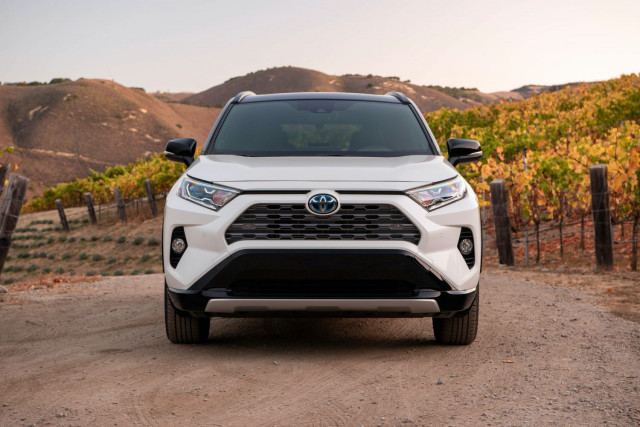
2021 Toyota RAV4 Hybrid
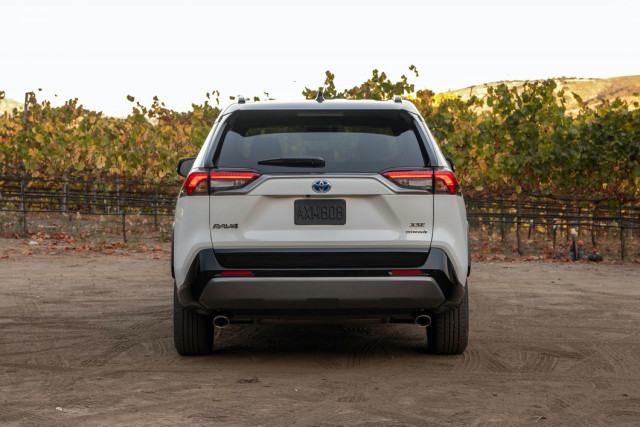
2021 Toyota RAV4 Hybrid
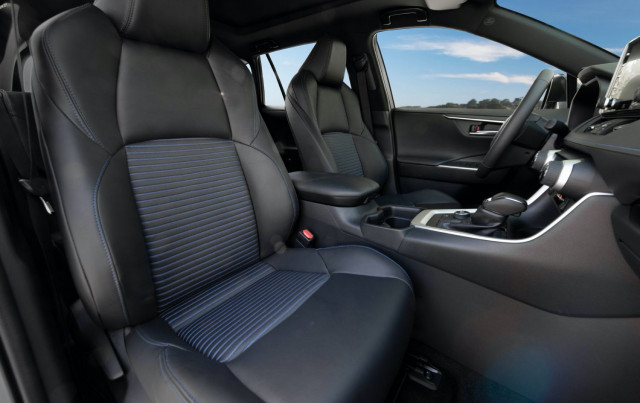
2021 Toyota RAV4 Hybrid

2021 Toyota RAV4 Hybrid
Part of what has made the RAV4 Hybrid such a big portion of RAV4 sales is that virtually all trim levels can be made hybrid. From LE to XLE, XLE Premium, XSE, and Limited models, the RAV4 Hybrid spans prices starting below $30,000 and ranging up to $36,780, fully optioned with a Smart Key system, moonroof, rain-sensing wipers, and heated steering wheel. The CR-V Hybrid comes in nearly as wide of a range, spanning EX, EX-L, and Touring versions, ranging from less than $32,000 up to $37,525—although Honda offers a long list of appearance and activity-oriented dealer-installed upgrades. All versions of the RAV4 Hybrid and CR-V Hybrid come with a 7.0-inch touchscreen with Apple CarPlay and Android Auto compatibility.
Across both of these lineups, the premium in going from a non-hybrid to a hybrid with equivalent equipment is roughly $1,000.

2021 Toyota RAV4 Prime XSE
One sidenote: Those who would rather have a plug-in vehicle should also take a look at the RAV4 Prime. Although thousands more, it offers better performance and a 42-mile all-electric range, plus a 38-mpg combined rating as a hybrid.
The RAV4 Hybrid offers somewhat higher mileage, by official estimates. It earns 41 mpg city, 38 highway, for a combined figure of 40 mpg. The CR-V earns 40 mpg city, 35 highway, and 38 mpg combined. Non-hybrid versions of the RAV4 and CR-V with all-wheel drive get 28 mpg and 29 mpg combined, respectively, so the hybrids offer a big running-cost advantage that won’t take long to pay off the premium.
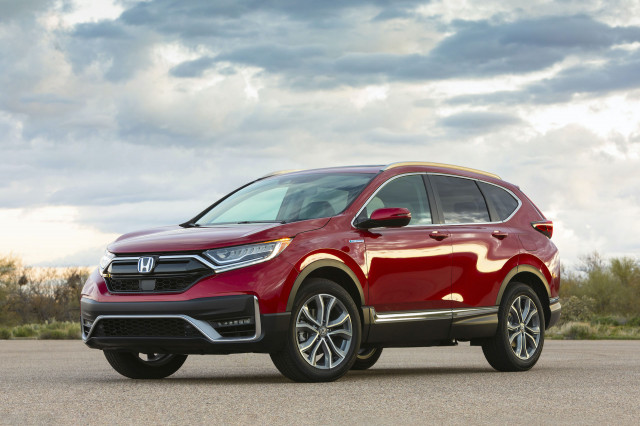
2021 Honda CR-V (CR-V Hybrid)
At present, the CR-V lineup has a slight edge over the RAV4 lineup—with a TCC 6.5 overall rating, versus a 6.4 for the 2021 Toyota RAV4—and it’s such a narrow edge here, too, it will depend on your own priorities as to which is better. In both cases, with value in mind, you’re getting the best of the lineup in choosing the hybrid.

